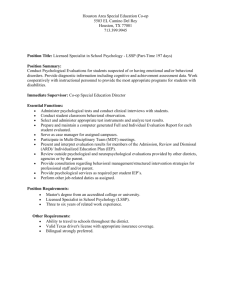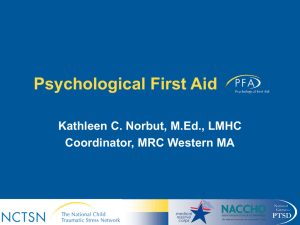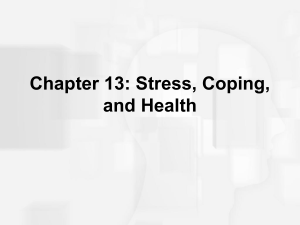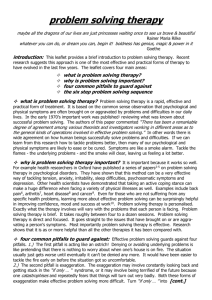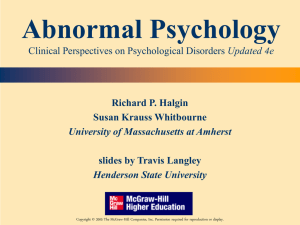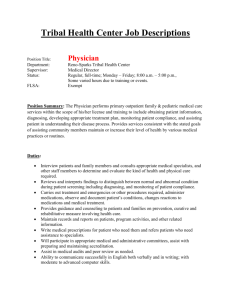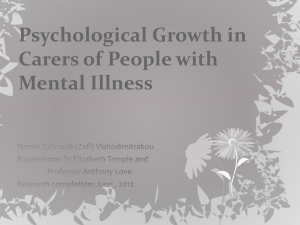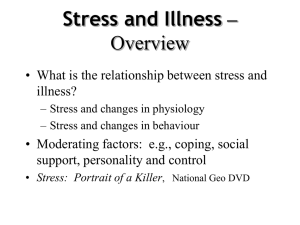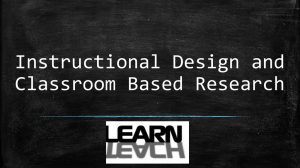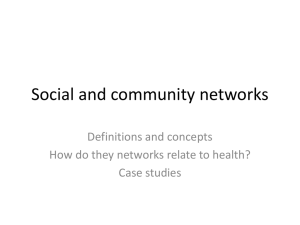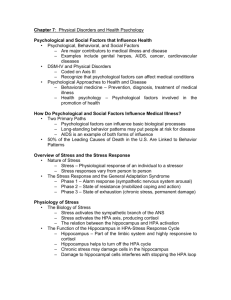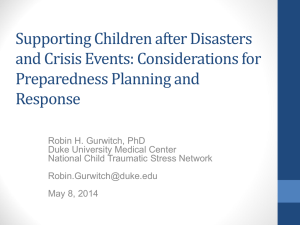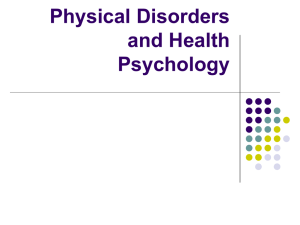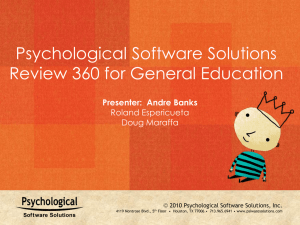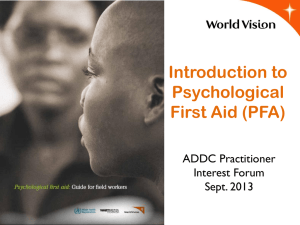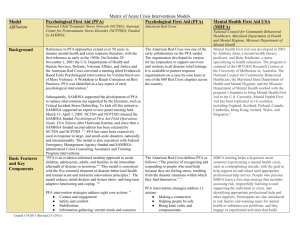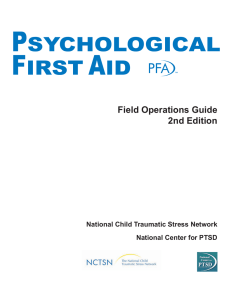Title of slide show - Minnesota Department of Health
advertisement
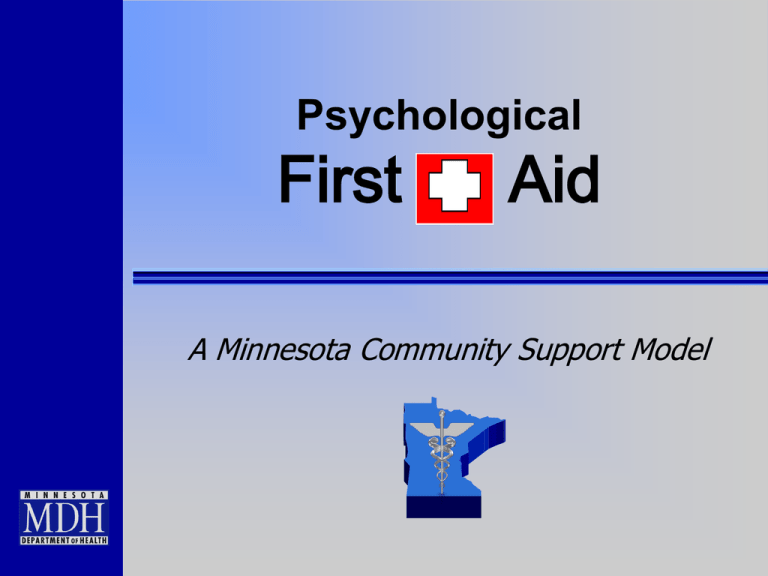
Psychological First Aid A Minnesota Community Support Model Psychological First Aid Principles and techniques of PFA meet four basic standards • Consistent with research evidence on risk and resilience following trauma. • Applicable and practical in field settings. • Appropriate to developmental level across the lifespan. • Culturally informed. Psychological First Aid A model that: • Integrates public health, community health, and individual psychology • Includes preparedness for communities, work places, healthcare systems, schools, faith communities, and families • Does not rely on direct services by mental health professionals • Uses skills you probably already have… Source: Gerald Jacobs, U.DMHI, 2005 What is Stress? The International Federation of the Red Cross defines stress as “A very broad term referring to the effect of anything in life to which people must adjust.” • For instance, anything we consider challenging causes stress, even if it is something we willingly choose to do. • The key is that stress requires us to adjust our attention and behavior and makes demands upon our energy. Psychosocial Stress Response Fear and Distress Response Impact of Event Behavior Change Psychiatric Illness Adapted from: Source: Butler AS, Panzer AM, Goldfrank LR, Institute of Medicine Committee on Responding to the Psychological Consequences of Terrorism Board of on Neuroscience and Behavioral Health. Preparing for the psychological consequences of terrorism: A public health approach. Washington, D.C.: National Academies Press, 2003. Common Physical Reactions Adults • Sleep difficulties • Gastrointestinal problems (Diarrhea, cramps) • Stomach upset, nausea • Elevated heart rate, blood pressure and blood sugar • With extended stress, suppression of immune system functioning Common Physical Reactions Children/Youth • • • • • • Headaches Stomachaches Nausea Eating Problems Speech Difficulties Skin eruptions Common Emotional Reactions Adults • • • • Fear and Anxiety Sadness and Depression Anger and Irritability Numb, withdrawn, or disconnected • Lack of involvement or enjoyment in favorite activities • Sense of emptiness or hopelessness Common Emotional Reactions Children/Youth • Anxiety & Vulnerability • Fear of reoccurrence • Fear of being left alone • Particularly if separated from family • Loss of “Sense of Safety” • Depression • Anger • Guilt Common Behavioral Reactions Adults • Family difficulties • Substance abuse • Being overprotective of family • Keeping excessively busy • Isolating oneself from others • Being very alert at times, startling easily • Avoiding places, activities, or people that bring back memories Common Behavioral Reactions Children/Youth • “Childish” or regressive behavior • May not be deliberate acting out • Bedtime problems • Sleep onset insomnia • Mid-night awakening • Fear of dark • Fear of event reoccurrence during night Common Cognitive Reactions Adults • • • • Difficulty concentrating Difficulty with memory Intrusive Memories Recurring dreams or nightmares • Flashbacks • Difficulty communicating • Difficulty following complicated instructions Common Cognitive Reactions Children/Youth • Confusion, memory loss, and disorientation • Difficulty in concentrating • May appear as behavioral problems in classroom • School may be where child functions best • Continuing Structure, sense of control • Social group Common Faith & Spiritual Reactions Adults & Children • Reliance upon faith • Questioning values and beliefs • Loss of meaning • Directing anger toward God • Cynicism Common Sensory Reactions Adults & Children • Sight • Sound • Smell • Taste • Touch An Event is More Stressful or Traumatic When…… • Event is unexpected • Many people die, especially • • • • children Event lasts a long time The cause is unknown The event is poignant or meaningful Event impacts a large area Footprint of Disasters The psychological “Footprint” of a disaster is larger Psychological than the medical “Footprint” – Greater number of individuals impacted – Greater geographical impact Medical Source: Shultz, Cohen, Watson, Flynn, Espinel, Smith. SAFETY, FUNCTION, ACTION: Psychological First Aid for Disaster Survivors. Miami FL: DEEP Center 2006 What assists our Emotional Re-Adjustment? • Acceptance of the event and our losses. • Identification, labeling, and expression of our emotions. • Regaining a sense of mastery and control over our life. Promote Safety • Remove from immediate danger area as soon as possible • Meet basic survival needs Calm & Comfort • Most often, people just • • • • need someone to talk to about their experience Someone to care Someone to really listen Someone to lean on or cry with Someone to BE PRESENT TO THEM! Source: Gerald Jacobs, U.DMHI, 2005 Active Listening Make it clear that you are listening by displaying: • Compassionate Presence • Body Language • Eye contact • Facial expression • Tone of voice Active Understanding • Try not to interrupt until • • • • • story ended Ask questions to clarify Establish sequence of events Avoid “Why?” and “Why not?” Don’t judge Avoid evaluation of their experience and their reactions Silence is O.K. Source: Gerald Jacobs, U.DMHI, 2005 Agitation • Sometimes, despite our best attempts, some people may become agitated • Refusal to follow directions • Loss of control, becoming verbally agitated • Becoming threatening • It is usually not personal • This is their reaction to an UNCOMMON situation, and it has nothing to do with you Be Kind, Calm, and Compassionate • Express patience and compassion, even if people are being difficult. • Speak in a calm voice. • Remain courteous and respectful of people – even if the other person does not! Psychological First Aid: Helping Others in Times of Stress Psychological First Aid Don’ts • Avoid asking for in-depth description of traumatic experiences. • Follow the lead of the individual in discussing what happened during the event. • Individuals should not be pressed to disclose details of any trauma or loss. . Source: Center for the Study of Traumatic Stress It is Not OK to suggest that… • • • • • • • • • Let’s talk about something else You should work toward getting over this You are strong enough to deal with this I know how you feel You’ll feel better soon You did everything you could You are lucky to be alive You need to relax It’s good that you are alive It is OK to… • Recommend substitute solutions that are: • more useful • less burdensome or • less likely to backfire • If you don’t know an answer, say “I don’t know but I might be able to help you find out.” • Or, “I’m not sure what to do, but I will be happy to help you find someone who does.” Provide Information on Coping • Provide basic information about common stress reactions • Provide basic information on ways of coping • First Aid Card • Teach simple relaxation techniques • Deep Breathing • Muscle relaxation Positive Coping Strategies • Actively seeking assistance • Reacting constructively to environmental challenges and recognizing potential for growth • Use of non-destructive defenses such as humor, exercise, good eating habits, time management, relaxation exercises Source: Adapted from SAMHSA DTAC Maladaptive Coping Strategies Excessive withdrawal, retreat, avoidance High use of fantasy; poor reality testing Impulsive behavior Venting on weaker individuals Over-dependent behavior Lack of empathy for others Connectedness • Help connect with friends & loved ones • Help connect with pets • Connect with disaster resources and support services • Connect with community resources and support services Brief Assessmment Identifies those who are distressed or acutely affected; those who demonstrate a disturbed mental state, cognitive impairment, or behavioral disturbance: – Identification of high-risk individuals and groups – Referral to mental health professionals – Access to hospitalization and outpatient treatment if needed Look for…. • Unresponsiveness to verbal questions or commands • Glassy eyed and vacant stare – unable to find direction • Disorientation (aimless disorganized behavior) • Strong emotional responses - uncontrollable crying, hyperventilating, rocking Alarm Bells/When to Refer • Harm to self • Saying they want to: “End it all” “Go to sleep and never wake up again” • Preoccupation with death • Giving away possessions • Excessive use of substances • Driving under influence • In some cases working under influence Alarm Bells/When to Refer • Harm to others – Child abuse – Spouse abuse • Loss of control • Significant withdrawal (as change in behavior) • Unable to care for self (cannot eat, bathe etc. - Vulnerable) Self Empowerment • Provide disaster and responder reintegration information • Engage towards meeting own needs-practical problem solving • Work to “normal life” activities • Promote Resilience • Everyone who experiences a traumatic event is touched by it • We have the ability to “bounce forward” to a “New Normal” Responder Stress Compassion Fatigue • “There is a cost to caring. We professionals who are paid to listen to the stories of fear, pain, and suffering of others may feel, ourselves, similar fear, pain and suffering because we care.” • “Compassion fatigue is the emotional residue of exposure to working with the suffering, particularly those suffering from the consequences of traumatic events.” Charles R. Figley, Ph.D. Practice Flexibility Recognize the limits of the Disaster situation • Limited resources • Atmosphere of chaos • Environmental pollution • Continued threats • Organizational and operational realities Self Care During Deployment • Self-monitoring and pacing • Regular check-ins with colleagues, family, and friends • Brief relaxation/stress management breaks basic bodily care and refreshment • Acceptance that you cannot change everything • Fostering of flexibility, patience, and tolerance Self Care After Deployment • Expect a reintegration period upon returning to your usual routine. • Pay attention to cues from your family that you are becoming too involved. • Prepare for worldview changes that may not be mirrored by others in your life. • Pay extra attention to rekindling close interpersonal relationships. Self Care After Deployment • Participate in formal help • Increase leisure activities, and management. • Pay extra attention to health and nutrition. • Practice good sleep routines. • Make time for self-reflection, insight. • Practice receiving from others. • Find things to make you laugh. Develop a Personal Resiliency Plan • Focus beyond the short term • • • • – DO IT NOW! Get to understand what triggers stress for you Know your personal unique stressors and Red Flags for further assistance Select from your own menu of positive coping responses Practice stress reduction and self care daily My Self Care Plan PFA Resources • Psychological First Aid, Field Operations Guide • http://ncptsd.va.gov/ncmain/ncdocs/manu als/PFA_2ndEditionwithappendices.pdf • Minnesota Department of Health • http://www.health.state.mn.us/oep/respon sesystems/behavioral.html Nancy Carlson Behavioral Health Preparedness Coordinator Minnesota Department of Health Office of Emergency Preparedness Phone 651-201-5707 Cell: 651-247-7398 Nancy.J.Carlson@state.mn.us MDH Behavioral Health Web Sites: www.health.state.mn.us/oep/planning/mhimpact.html
